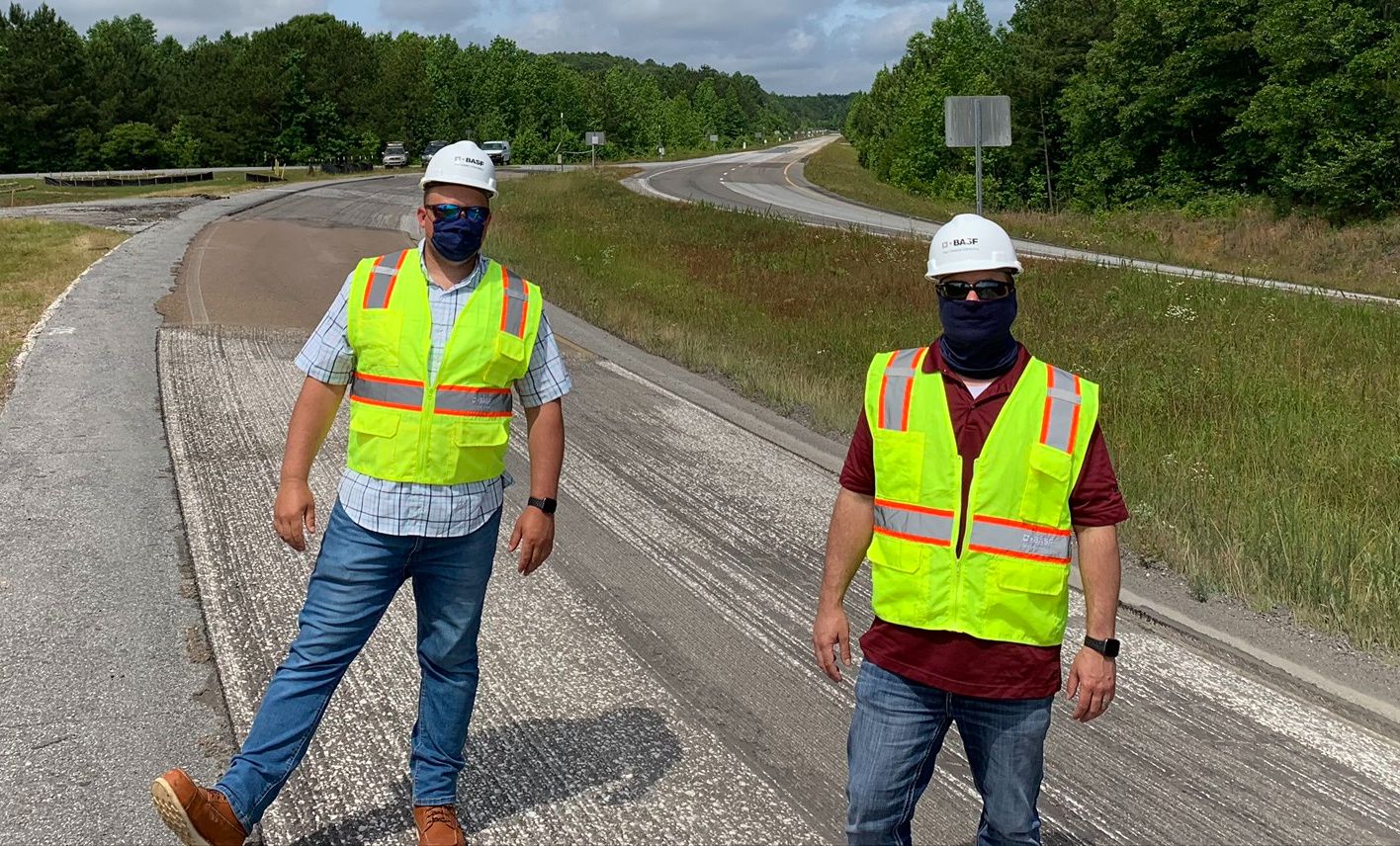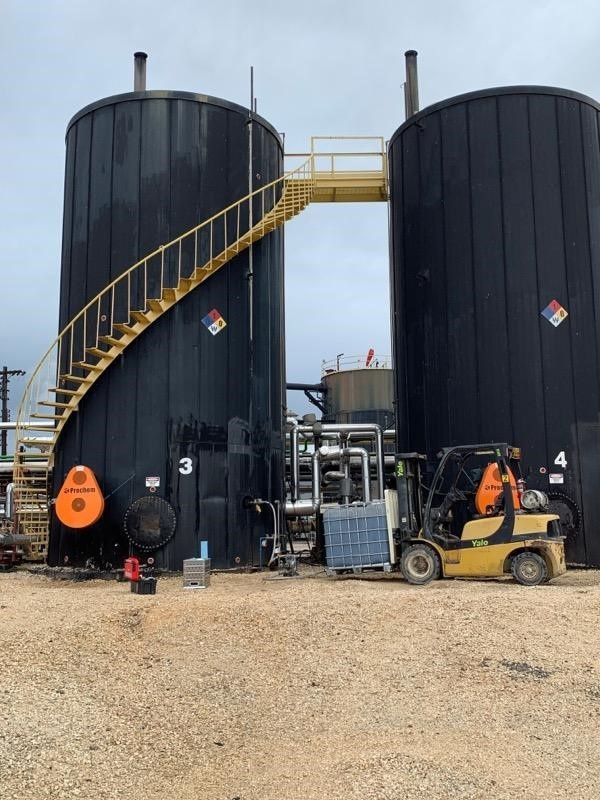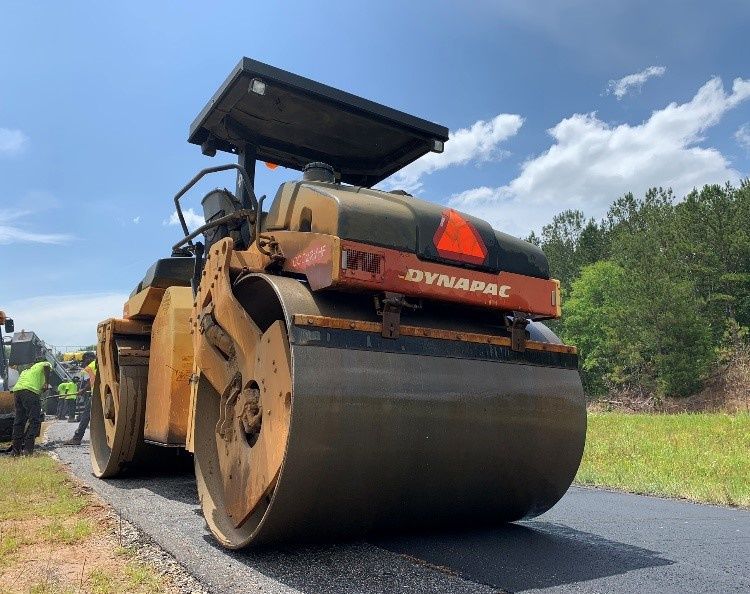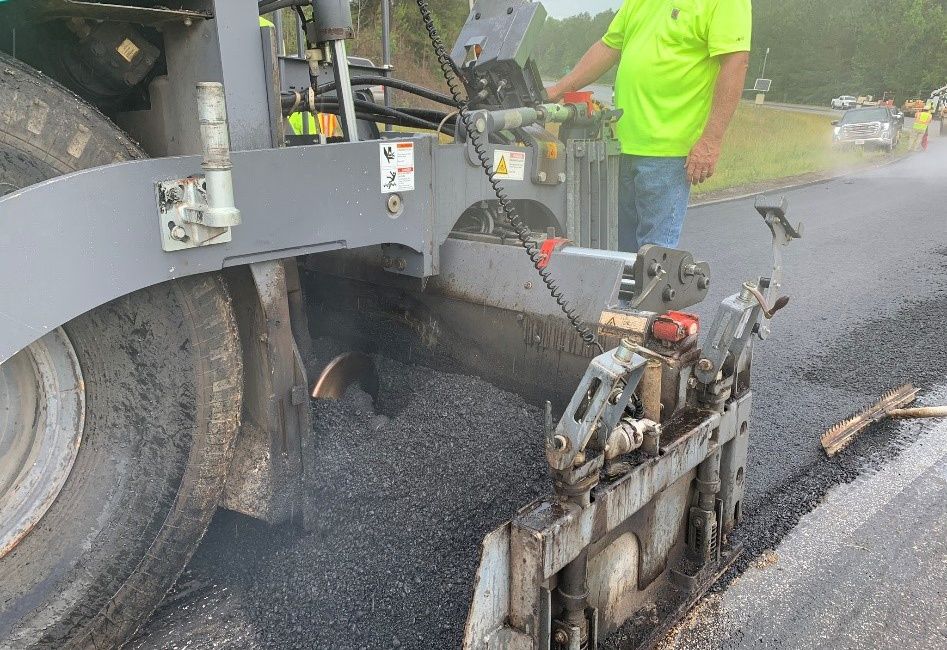BASF, NCAT Partner for Paving Trial
BY Patricia Presswood

A low viscosity reactive liquid asphalt additive, B2Last® by BASF Corporation, was recently introduced at the 2020 Petersen Asphalt Research Conference (PARC). It is a modification technology based upon a reactive chemistry that combines with the liquid asphalt at a molecular level to improve the functional characteristics of the neat asphalt.
B2Last is compatible with most liquid asphalts thus is ideal for new pavement construction and pavement preservation initiatives. B2Last is designed to increase the useful temperature interval (UTI) of the liquid asphalt, maintain workable viscosity levels, and reduce stripping of the aggregates, leading to a more durable pavement.
“Functional performance improvement levels can be tailored or made ‘on-demand’ by binder formulators to meet or exceed flexible pavement specifications,” said Bernie Malonson, B2Last marketing manager, BASF Monomers, North America. “Since B2Last is a liquid, there are no solids to grind or melt, less energy is required to produce modified asphalt pavements, and it supports the American Association of State and Highway Transportation Officials (AASHTO) specifications.”
While specific states vary in their authorized materials, B2Last can support both AASHTO M320 and M332 performance grade (PG) specifications. In many cases, modified asphalt producers have noted that they are able to use less B2Last and simplify their formulations.
Although successful paving operations have been conducted globally, BASF has partnered with the National Center for Asphalt Technology (NCAT) in Auburn to conduct a Phase I study as part of BASF’s ongoing program of B2Last trial evaluation.
Chemistry & Study Design

The material was continuously mixed at 350° F until shipping to achieve full reaction within the binder. To ensure completion, a portable on-site FT-IR took hourly readings.
B2Last is designed to improve adhesion of the asphalt mix by crosslinking the liquid binder asphaltenes. When handled with appropriate environmental controls, B2Last modification does not require any unique personnel protective equipment (PPE).
NCAT Phase I paving studies typically take six to 12 months and include a laboratory testing program to determine the mechanistic and performance properties of asphalt binders and mixtures. The core NCAT research team led by Dr. Nam Tran, assistant director, NCAT, with paving operations overseen by Dr. Buzz Powell, associate director, NCAT, and additional support provided by Jason Nelson, test track manager, and Adam Taylor, assistant research engineer, were on site for the trial.
The primary objective of this Phase I study is to evaluate the field constructability of an asphalt mixture modified with B2Last. The information obtained from this study will be used for a structural pavement analysis to plan and design a full-scale experiment for placement on the Pavement Test Track in 2021 to fully evaluate the B2Last modifier.
In May of 2020, Brian Orr, senior asphalt technologist, BASF Monomers, NA, and Joshua Compeau, technical specialist, BASF Monomers, NA, traveled to Alabama to oversee liquid asphalt terminal modification. In the case of a new asphalt binder modifier such as B2Last, it is best to produce these materials at a terminal asphalt plant and then pave the mix in a trial section with low traffic.

The NCAT research team noted that no modifications to the rolling pattern were needed for mix produced with the B2Last-modified binder than a mix produced with an SBS-modified binder to achieve an equal level of density.
A base binder of PG67-22 was used to meet the ALDOT required grade of binder. This binder was modified with a 2 percent concentration of B2Last to reach an acceptable PG76-22. The process used to modify the binder was achieved by injecting the B2Last with a 2-inch diaphragm pump through an injection port into 50 tons of asphalt binder, which was used to ensure the binder reached an adequate level for mixing and agitation in the modification tank. After injecting the B2Last, monitors took hourly readings around the work area for any potential off gassing. The material was continuously mixed at 350° F until shipping to achieve full reaction within the binder.
To ensure completion, a portable, on-site Fourier Transform Infrared Spectrometer (FT-IR) took hourly readings.
“The main challenge in using reactive chemistries is to ensure that the product is allowed sufficient time to completely react within the liquid asphalt,” Orr said. “The completion of this molecular reaction is what improves the functional characteristics of the liquid asphalt.”
NCAT Paving Overview
The Phase I study was carried out by milling the surface layer (approximately 2 inches thick) of a 100-foot section with consistent foundation support on the exit ramp and then resurfacing this section with a B2Last-modified mixture.
The B2Last-modified binder was hauled from a production facility in south Alabama over 200 miles to East Alabama Paving’s asphalt plant in Auburn, Alabama. Upon arrival, it was several hours before it was possible to produce the required asphalt mix for paving.
“Although the transport tanker had cooled significantly, the B2Last-modified binder was successfully pumped from the tanker to the mix plant’s liquid asphalt circulation system and used to produce asphalt mix in real-time without being stored and reheated in a permanent storage tank,” Powell said. “No significant differences were noted during plant production pumping of the B2Last-modified binder from the tanker truck than conventional mix production using a heated binder from a permanent storage tank.”
Hot-mix asphalt produced with B2Last-modified binder was transported in a conventional triaxle dump truck, and no issues were noted with loading, hauling or unloading the modified asphalt mix. Quality control test results for mix produced with the modified binder matched what researchers expected from an asphalt mix made with an SBS-modified binder using the same plant settings.
“No issues with material transfer were observed by researchers or reported by the contractor,” Powell said.
The mix produced with the B2Last binder was re-blended at the paving site using a Shuttle Buggy before dumping into the paver to construct the test section. Behind the screed, mix produced with the modified binder was observed to exhibit no unusual characteristics than the mix made with an SBS-modified binder (e.g., no “spider webs,” strings, blotches, etc.).
“The slight difference in density,” Powell said, “is likely not statistically significant.”
The NCAT research team noted that no modifications to the rolling pattern were needed for mix produced with the B2Last-modified binder compared to a mix produced with an SBS-modified binder to achieve an equal level of density. The density of the B2Last section was 95.3 percent, which compared well to a typical density of an SBS mix.
The paving crew was interviewed during paving and reported that the mix produced with the B2Last-modified binder was no different to work with than mix produced with an SBS-modified binder.
“Response from construction companies and their paving crews has been overwhelmingly positive,” Malonson said. “In paving operations in both the United States and Europe, paving crews have commented that there is significantly less ‘asphalt’ smell as B2Last can lower volatile organic compounds (VOCs). Paving crews have also commented that B2Last mixes have significantly less build up and need for release agent than traditional polymers. Finally, pavements modified with B2Last have improved compaction over standard polymer modified asphalts.”
Monitoring Field Performance

The mix produced with the B2Last binder was re-blended at the paving site using a Shuttle Buggy from Roadtec Inc., Chattanooga, before dumping into the paver to construct the test section.
To assist the on-going field performance monitoring program, structural pavement analysis of the B2Last-constructed section will be conducted as a function of the truck traffic exiting the Test Track. Traffic is estimated to be 13,500 ESALs per month.
Surface performance data will be collected four times, including summer, fall and winter 2020 and spring 2021. The data collected will be used to evaluate the field performance and structural stiffness of the pavement sections to determine how they will be affected by various loading and temperature conditions.
“The first step is to determine the mechanistic property, or the dynamic modulus or E* and cyclic fatigue, of the mixtures,” Tran said. “This data is necessary for structural pavement design and analysis.”
Plant-produced mixes and field cores will be tested as part of the two-step Phase I evaluation stage. Testing will be conducted in compliance with AASHTO T 378-17 and TP 133-19 on small-sized specimens prepared from plant mix and field cores. The results will be used to develop full master curves and damage characteristic curves for the B2Last-modified mixture.
In the second step, the following performance properties of the plant-produced mixture will be determined for the mixture performance evaluation:
Rutting resistance is determined using HWTT (AASHTO T324-17); and
Cracking resistance is determined using IDEAL-CT (ASTM D8225-19).
“As of August 19, 2020, approximately 40,000 ESALs have been applied to the 2-inch mill/inlay (on 3 inches of underlying mix, making a total thickness of 5 inches) using mix produced with the B2Last-modified binder,” Powell said. “No rutting or cracking has been observed.”
In conclusion, “B2Last brings a new type of science from an engineering perspective,” stated Phillip Blankenship, civil engineer/owner at Blankenship Asphalt Tech and Training PLLC. “We are used to dealing with products that are blended. B2Last is fully reacted, which means it becomes one with the asphalt – it’s not a two-part system you have to stir continuously. Once contractors get B2Last-modified asphalt into their tank, it is business as usual.”
For more information, visit b2lastna.basf.com.
